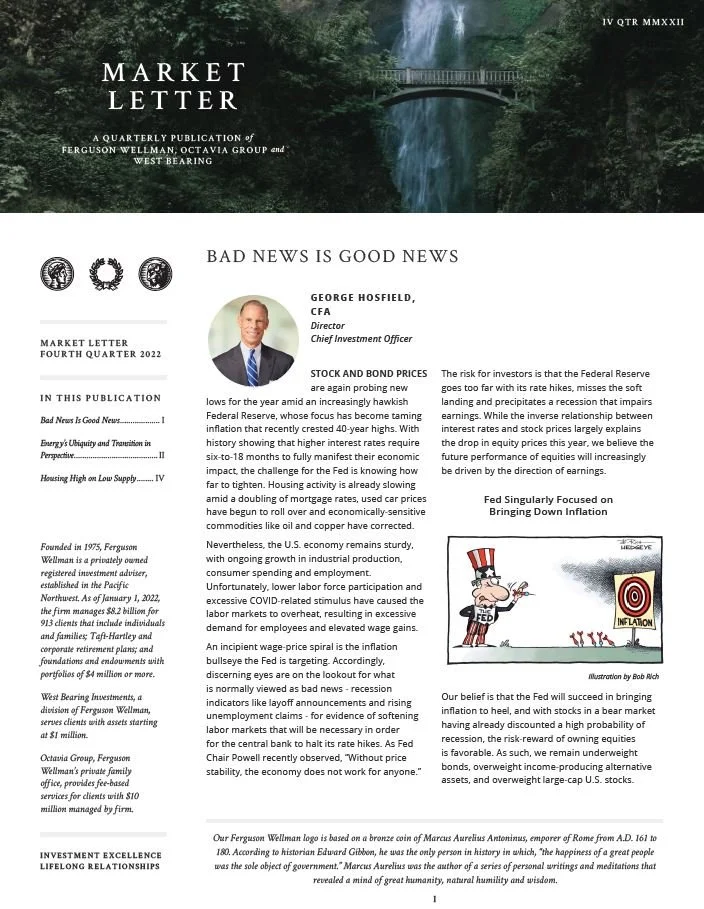As the calendar turned to the final quarter of 2024, there was plenty of economic and geopolitical news for investors to digest.
Fourth Quarter 2022 Market Letter: Bad News Is Good News
Read our Market Letter publication for the fourth quarter 2022 titled, Bad News Is Good News, in which George Hosfield, CFA, Peter Jones, CFA, and Joe Herrle, CFA, share our thoughts on inflation, interest rates, the energy sector and housing supply in the United States.
Higher Rates to the Rescue
With second quarter earnings season complete, a relatively quiet week of company specific news was supplanted by central bank action in the European Union and Canada, with both raising their short-term interest rates by three-quarters of a percentage point. The European Central Bank (ECB) has now lifted rates off the zero bound, to 0.75%, but is behind both the U.S. Federal Reserve and the Bank of Canada in the amount of tightening already implemented.
Inflation Redux
The last time I wrote the blog was April 14 and inflation data was the topic du jour. Serendipitously, the July inflation announcement was the major market event this week. So, to keep me honest, let us revisit some items from the April post.
Mastering Expectations
 by Shawn Narancich, CFAExecutive Vice President of Research
by Shawn Narancich, CFAExecutive Vice President of Research
A Tradition Unlike Any Other
As another Masters golf tourney gets underway in Augusta, Georgia this week, investors are beginning to process the first reports of a dawning earnings season; as well, they have been jolted by a strong dose of deal news this week totaling well over $100 billion in announced acquisitions. Whether this flurry of activity heralds meaningfully more late-cycle deal making remains to be seen, but low interest rates as well as low oil prices support the rationale for energy deals like Royal Dutch’s $70 billion purchase of British energy company BG Group. Speculation is rife that rivals Exxon and Chevron could be compelled to do the same. Although buying another European producer might make more sense now in light of the strong dollar, we view neither of these integrated oil producers as likely to attempt a large deal for a major peer. More likely are deals for smaller independent U.S. producers with quality acreage in key Texas shale plays like the Permian Basin and the Eagle Ford.
Ready, Fire, Aim
As Royal Dutch jockeys for position in Big Oil, energy investors attempting to divine the low in prices for this cycle were forced to confront the not-so-shocking news out of Iran that that their “supreme leader” Khamenei is calling for the immediate lifting of economic sanctions in return for concessions limiting the country’s nuclear program. As well, he apparently disdains the idea of nuclear inspections that would confirm the country’s compliance with key provisions of the agreement reached in Switzerland last week. All of which leads us to conclude that predictions about a wave of new Iranian oil buffeting the markets any time soon is premature. From our perspective, the likelihood of reaching a final nuclear agreement with Iran looks increasingly unlikely.
Skating to Where the Puck Will Be
Geopolitics aside, we believe oil prices have bottomed and that markets will tighten meaningfully in the second half of this year, pushing prices closer to the marginal cost of production estimated to be somewhere between $75 and $100/barrel. From an investment perspective, we are overweight the energy sector and favor upstream producers and the service companies that enable their production as the two groups most likely to benefit from rising oil prices.
And They’re Off!
Alcoa marked the unofficial beginning of first quarter reporting season by announcing better-than-expected earnings on healthy growth in aluminum demand from both the aerospace sector as well as the emerging market in autos. Unfortunately for shareholders, the results met with a thud by investors who drove the stock down 3 percent on fears that aluminum prices will succumb to excess supply from China, the world’s largest producer. Next week will mark the first full week of earnings, with the money center banks and a few select industrial and healthcare companies on tap to deliver their numbers. In contrast to depressed energy results amid low oil prices, we expect earnings growth from sectors like healthcare and technology.
Our Takeaways from the Week
- Deal making is being stimulated by low oil prices, low interest rates and a strong dollar
- Investors are beginning to turn their attention to first quarter earnings
One Thing Leads to Another
 by Shawn Narancich, CFAExecutive Vice President of Research
by Shawn Narancich, CFAExecutive Vice President of Research
Too Much of a Good Thing?
As Europe begins to make a down payment on its one trillion euro quantitative easing program, the U.S. dollar’s rapid gains have become parabolic and begun to take a dent out of investors’ U.S. stock portfolios. A strong currency is commonly cited for its endearing qualities of reducing inflation and attracting investment, but with the trade-weighted dollar up almost 25 percent since last summer, more and more companies are watching their bottom lines suffer as foreign profits get translated into fewer dollars. We would observe that when an asset’s orderly gains begin to rise at an accelerating rate, the asset is beginning to resemble a bubble, regardless of whether it is tech stocks in early 2000 or the dollar at present.
Bidding Adieu to ZIRP
Because the U.S. economy continues to outpace those of other developed nations at a time when the Fed is preparing to raise interest rates, we aren’t calling for a top on the dollar, but we do believe it is due for a breather. What we would conjecture is that the best of the greenback’s gains may have already been realized, acknowledging that while the Fed’s mandate to promote full employment is being realized, it is in danger of falling short of its other goal, that of maintaining stable prices (defined roughly as two percent inflation). We envision lift-off from the Fed’s zero interest rate policy (ZIRP) later this year, but with inflation increasingly subdued at the imported goods level in addition to that caused by lower oil prices, the Fed is unlikely to tighten as aggressively as the dollar would imply.
Skate to Where the Puck Will Be
We observe in bemused fashion the financial press waxing bearish about the supposed lack of storage capacity for U.S. oil production. Yes, storage builds have occurred at the Cushing, Oklahoma delivery site for the commonly quoted West Texas Intermediate (WTI) oil contract, as an unusually large amount of refining capacity has been temporarily idled for seasonal maintenance and one northern California refinery is offline because of the United Steelworkers’ refinery strike. This too shall pass. With gasoline refining margins now surpassing the robust level of $30/barrel (thanks to strong demand stimulated by low pump prices and discounted WTI oil), refiners are heavily incented to return idled capacity as soon as possible.
Always Darkest Before the Dawn
Are oil prices at a bottom today? Markets tend to overcorrect on the way up and do the same thing on the way down, so although fundamentals of the oil market don’t appear to support $45/barrel oil for any substantial length of time, the price of oil could go lower in the next month or two. But we don’t manage client portfolios with a one or two month time horizon and what we will say is that this cycle is playing out just like we would expect. U.S. drilling activity has plummeted in response to low oil prices, down 42 percent since September, while demand for gasoline, diesel and jet fuel hasn’t been this robust in years. By our estimation, faster demand growth and U.S. production that we believe is set to begin declining are the key ingredients to a recipe for higher prices in the second half of this year. Being overweight energy stocks has not felt good lately, but we are confident that the bearish headlines on oil herald something much more constructive for energy investors.
Our Takeaways from the Week
- Increasingly heady dollar gains are beginning to negatively impact U.S. stock prices
- The most recent declines in oil appear long in the tooth








